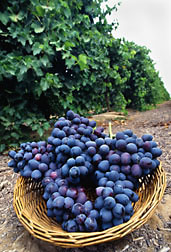PCR Fine-Tuned for Better Plant Disease Detection
Plant diseases not only cause significant crop losses, but can also severely damage export markets. The key to controlling any plant disease is a rapid, sensitive, and accurate diagnosis. Polymerase chain reaction (PCR)-based tests are prized tools for diagnosing plant diseases. But PCR’s ability to obtain a genetic fingerprint that conclusively identifies the pathogen hinges on there being a minimum number of target cells. Otherwise, its genetic material can’t be probed and multiplied in amounts necessary for detection. This diagnostic shortcoming can be especially costly when asymptomatic seed or plants intended for commercial sale are certified as pathogen free when, in fact, they’re not.
Now, a solution to the problem is at hand, thanks to a patented procedure devised by Agricultural Research Service plant pathologist Norm Schaad and colleagues. Their technique increases numbers of the target organism in a sample by using growth-promoting agar or liquid media before PCR. In 4 to 72 hours, depending on the pathogen, “the target cells make many thousands of copies, enabling detection by direct PCR,” explains Schaad, now retired from the ARS Foreign Disease-Weed Science Research Unit at Fort Detrick, Maryland.
“What makes the procedure so easy to design is that we only need to grow pinpoint-size colonies for PCR,” he says. These small colonies are washed from the agar-media plates and used directly for PCR. This eliminates the need for chemicals such as phenol, which is used to extract the DNA needed for conventional PCR.
Besides increasing sensitivity by 100- to 1,000-fold over conventional PCR methods, the enrichment technique, dubbed “Bio-PCR,” stops substances called “inhibitors” from interfering with the action of a key enzyme, Taq polymerase. These inhibitors can come from plant extracts and even bacterial cells. During the actual PCR procedure, polymerase mass-produces, or “amplifies,” specific fragments of the targeted bacterium’s DNA so that it can be detected.
Schaad codeveloped Bio-PCR with Nikolas J. Panopoulos and Efstathios Hatziloukas, both formerly with the University of California-Berkeley.
Bio-PCR works best with such fast-growing bacteria as Ralstonia solanacearum (bacterial wilt of potato and tomato) and Acidovorax avenae (bacterial fruit blotch of watermelon), where only 48 hours are needed for enrichment.
Even detection of the extremely slow-growing Xylella fastidiosa (Pierce’s disease of grapes and leaf scorch of shade trees) is improved by Bio-PCR. Indeed, in studies with X. fastidiosa, Bio-PCR detected the bacterium in 90 percent of infected grape samples, whereas conventional PCR detected just 13 percent.
“Conventional PCR does not work well with Xylella because of inhibitors,” says Schaad. “That’s a big advantage of Bio-PCR: By plating (growing bacteria) on agar media, the inhibitors are absorbed, and you can get a positive result in 4 to 5 hours.”
Other researchers have shown Bio-PCR’s inhibitor-eliminating enrichment step works in ferreting out hard-to-detect cells of human pathogens such as Escherichia coli O157:H7, offering food-safety applications as well. In the case of E. coli, only 2-4 hours of enrichment are needed.—By Jan Suszkiw, Agricultural Research Service Information Staff.
This research is part of Plant Diseases, an ARS national program (#303) described at www.nps.ars.usda.gov.
To reach scientists mentioned in this article, contact Jan Suszkiw, USDA-ARS Information Staff, 5601 Sunnyside Ave., Beltsville, MD 20705-5129; (301) 504-1630.
"PCR Fine-Tuned for Better Plant Disease Detection" was published in the April 2011 issue of Agricultural Research magazine.







